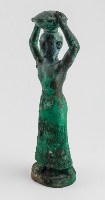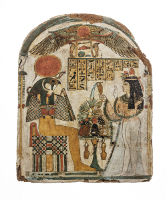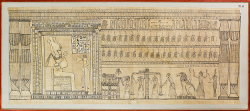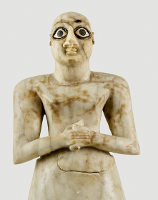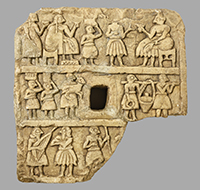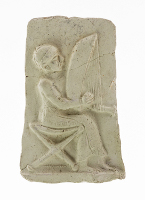Foundation Figurine of King Ur-Nammu
King Ur-Nammu rebuilt and enlarged one of the most important temples in ancient Mesopotamia - the E-kur of Enlil, the chief god of the pantheon. This figurine, which was buried in a foundation box beneath one of the temple towers, represents the king at the start of the building project - carrying on his head a basket of clay from which would be made the critically important first brick. The foundation deposit also contained an inscribed stone tablet; beads of frit, stone and gold; chips of various stones; and four ancient date pits found perched atop the basket carried by the king.
Funerary Stela
Found in the Ramesseum at Thebes, this painted funerary stela was erected to commemorate the lady Djed-Khonsu-es-ankh. The deceased woman, in a diaphanous white gown, wears a cone of perfumed beeswax and a water lily on her head. She pours a libation over a table of food offerings and raises her hand to greet the seated god Re-Harakhty, a form of the ancient Egyptian sun god. The hieroglyphic signs offer a prayer asking the gods to supply food and drink for the survival of her spirit in the netherworld.
The inscription, a standard offering formula, reads:
An offering which the King gives to Re-Harakhty, the Great God, Lord of Heaven, that he may give invocation-offerings consisting of offerings and food to the Osiris, Lady of the House, the noblewoman, Djed-Khonsu-es-ankh, deceased, daughter of the priest of Amun-Ra, King of the Gods, Master of the Secrets of the Garments of the Gods, Ser- Djehuty.
Relief from the Tomb of Mentuemhat
The ancient Egyptians decorated the walls of their tombs with elaborate scenes showing the type of life they wished to live after death. This relief fragment comes from the tomb of Mentuemhat, a governor of Thebes. One of the most powerful men of his time, Mentuemhat was able to employ the best artists to carve and paint scenes of abundance that would satisfy his every need in the afterlife.
In the relief above, oarsmen paddle small boats made of papyrus bundles through waters teeming with fish. The first boat contains two oarsmen and a third figure, perhaps identified as an overseer by his staff (?) and gesture, sitting between wicker baskets piled high with fruit.
Mother Nursing Child
This simply formed and elaborately decorated nursing female probably represents a Cypriot mother goddess. Her facial features (including ears pierced for added earrings) and her limbs, breasts, and navel (?) are rudimentarily indicated. Bands of incisions suggest necklaces encircling her neck and patterns on her long, sheath-like garment. In her arms she holds an elaborate cradle containing an infant who suckles from her left breast.
Book of the Dead
The Book of the Dead was a collection of spells, hymns, and prayers intended to secure for the deceased safe passage to and sojourn in the other world. The sections of papyrus on display to the left and right are from one of these long scrolls, which was cut into fifteen sections in modern times.
The illustration to the left shows the judgement of the soul before Osiris, the god of the dead, who determines the deceased's worthiness to enter the next life by assessing his earthly deeds. The heart of Yartiuerow (the deceased) is being weighed in the balance against the feather of the goddess Maat, representing truth and justice. The jackal-god Anubis tips the balance in Yartiuerow's favor while the falcon-headed god Horus looks on and the ibis-headed Thoth, the secretary of the gods, records the favorable verdict. Yartiuerow himself stands on the right, his hands raised in jubilation, accompanied by the goddess Maat. Before him is a monster-part hippopotamus, part crocodile, and part lion- which would have annihilated him had the judgement been unfavorable.
The title of the Book of the Dead and its method of use are stated in the horizontal line at the top of the section exhibited to the right: "Beginning of the spells for going forth by day which raise the glorious ones (i.e., the dead) in the cemetery. To be said on the day of burial of entering in after going forth, by Osiris Yartiuerow, deceased." The vignette below shows part of the funeral procession. The sledge bearing the coffin is drawn by oxen. Two smaller sledges, each drawn by a man, follow. The one behind the coffcin bears the canopic box containing the four jars in which the viscera were preserved. On its lid lies a figure of the mortuary god Anubis in jackal form.
Colossal Statue of Tutankhamun
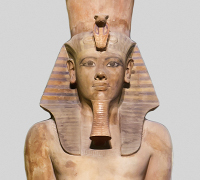 Oriental Institute archaeologists working at Thebes excavated this statue of King Tutankhamun. It had been usurped by succeeding kings and now bears the name of Horemheb.
Oriental Institute archaeologists working at Thebes excavated this statue of King Tutankhamun. It had been usurped by succeeding kings and now bears the name of Horemheb.
Tutankhamun wears the double crown and the royal nemes headcloth of the pharaohs; a protective cobra goddess (uraeus serpent) rears above his forehead. In his hands the king grasps scroll-like objects thought to be containers for the documents by which the gods affirmed the monarch's right to divine rule. The sword at his waist has a falcon's head, symbol of the god Horus, who was believed to be manifested by the living pharaoh. The small feet at the king's left side were part of a statue of his wife, Ankhesenpaamun, whose figure was more nearly life-sized.
The facial features of this statue strongly resemble other representations of Tutankhamun from his famous tomb, which was discovered relatively intact in the Valley of the Kings.
Two Assyrian Officials
 This relief comes from a wall just outside the throne room of Sargon II's palace. Two court officials - who are beardless and, therefore, possibly identifiable as eunuchs - are shown marching toward the king. The second figure motions to the line of men that stood behind him to come forward toward the king. He stands with his back toward the viewer, as can be seen by the position of his hands and garment, which covers his left shoulder. Traces of the paint originally used for coloring the sculpture still remain on portions of the relief.
This relief comes from a wall just outside the throne room of Sargon II's palace. Two court officials - who are beardless and, therefore, possibly identifiable as eunuchs - are shown marching toward the king. The second figure motions to the line of men that stood behind him to come forward toward the king. He stands with his back toward the viewer, as can be seen by the position of his hands and garment, which covers his left shoulder. Traces of the paint originally used for coloring the sculpture still remain on portions of the relief.
The ankle-length robes of the attendants are ornamented with squares and trimmed with fringe and beads along the lower edges. A diagonal band of red crosses the chest. Each courtier wears wire bracelets, earrings, and sandals which are held in position with toe- thongs and straps.
This relief stands about eleven feet high and weighs approximately two and a half tons.
Bronze Statuettes
Archaeologists found these three statuettes in a cache that contained three male and three female figurines. They are the earliest known metal castings of human figures in the round from Syria. The males wear broad belts and helmets covered with a silver alloy; they probably once held weapons in their upraised hands. The naked females' hair is held in place with a headband and bound in the back in an elaborate chignon. They cross their arms and grasp their breasts in their hands - a common ancient pose that probably connotes fertility. The statuettes were intended to be mounted in some fashion, for a tang projects below the feet of each one.
The skill with which these unique pieces were modelled and the technical knowledge that was needed for their casting reveal surprisingly high standards of artistic and technical achievement in Syria at the beginning of the third millennium B.C.
Victorious Assyrian Soldiers
After they had conquered Tell Ta'yinat, the Assyrians carved these reliefs and used them to decorate a palace or public structure. The scene shows victorious Assyrian soldiers carrying the cut-off heads of their defeated enemies to a location where the number of those slain would be counted. Beneath the soldiers' feet lie the decapitated bodies. Each soldier wears a helmet, carries a bow and quiver over his shoulder, and holds three arrows in his right hand. At a later date, perhaps after the decline of Assyrian power, the reliefs were reused, face-down, as paving stones.
Four-Faced God and Goddess

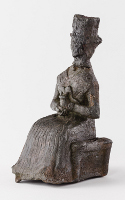 Illicit diggers found these four-faced statuettes, which may represent a god of the four winds and a goddess of rainstorms. The god wears a low cap with a pair of horns meeting above each face. He carries a scimitar in his right hand and places his left foot upon the back of a crouching ram. The goddess's tall crown, again with a pair of horns above each face, has the shape of a temple facade or altar. She grasps in her hands a vase from which flow streams of water; a rippled water pattern covers her garment.
Illicit diggers found these four-faced statuettes, which may represent a god of the four winds and a goddess of rainstorms. The god wears a low cap with a pair of horns meeting above each face. He carries a scimitar in his right hand and places his left foot upon the back of a crouching ram. The goddess's tall crown, again with a pair of horns above each face, has the shape of a temple facade or altar. She grasps in her hands a vase from which flow streams of water; a rippled water pattern covers her garment.
Sumerian Statuette
During the Early Dynastic Period in Mesopotamia, statuettes were placed in sanctuaries as votive offerings and were later buried when the temple was remodelled or rebuilt. This representation of a Sumerian standing reverently before his god is one of a group of sculptures found buried in a pit next to the altar of the Abu Temple at Tell Asmar. It is thought to depict a priest because it lacks the full beard and long hair of other male statues of its type.
Banquet Plaque
The top register of this plaque shows a seated man and woman celebrating an unidentified event or ritual by participating in a banquet. Two servants attend them while others bring a jar (probably filled with beer), an animal to be slaughtered, and other edibles carried in bundles on their heads. Musicians and dancers in the bottom register add to the festivities.
Plaques such as this were part of a door-locking system for important buildings. The plaque was embedded in the doorjamb and a peg, inserted into the central perforation, was used to hold a hook or cord that secured the door and was covered with clay impressed by one or more seals.
Cylinder Seal
 This cylinder seal was dedicated to a little-known goddess, Ninishkun, who is shown interceding on the owner's behalf with the great goddess Ishtar. Ishtar places her right foot upon a roaring lion, which she restrains with a leash. The scimitar in her left hand and the weapons sprouting from her winged shoulders indicate her war-like nature.
This cylinder seal was dedicated to a little-known goddess, Ninishkun, who is shown interceding on the owner's behalf with the great goddess Ishtar. Ishtar places her right foot upon a roaring lion, which she restrains with a leash. The scimitar in her left hand and the weapons sprouting from her winged shoulders indicate her war-like nature.
Plaque Showing a Harpist
Harps are known from the earliest period of written history, but the fringed robe and close-fitting cap of this harpist are typical for the early second millennium B.C. in Mesopotamia. Clay plaques from this period depict musicians playing a variety of stringed, percussion, and wind instruments. The casting of plaques was a simple and inexpensive way to produce relief images, since numerous plaques could be made from a single mold.
King Ashurnasirpal II
Room G in Ashurnasirpal II's palace may have served as the setting for a ritual by which weapons were purified. The walls of this chamber were adorned with exceptionally well-carved and minutely detailed reliefs showing the king standing between, alternately, two courtiers and two winged genies. This fragment shows the king himself, identifiable by his fez-shaped cap surmounted by a conical spike. Originally, this piece formed part of a scene. The king, grasping a bow, stood ready to pour a libation from a cup poised delicately on the tips of his fingers. Facing him was an attendant who carried a fly-whisk with which to banish insects from the royal presence.

